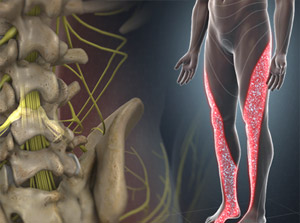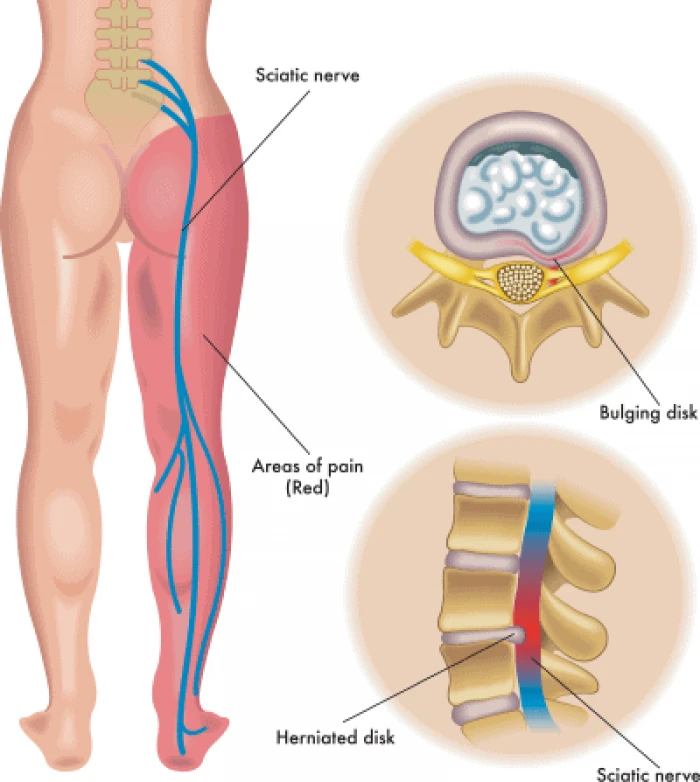The Centers for Advanced Orthopaedics is redefining the way musculoskeletal care is delivered across the region with locations throughout Maryland, DC, Virginia and Pennsylvania.
Sciatica: Causes, Symptoms, & Treatment
Have you ever pinched a nerve while lifting a heavy box or moving furniture? You reach down, lift, and bam—a shooting pain runs down your leg. We have all been there, but in some cases this pain may last longer than usual—sometimes for weeks. If this is the case, the culprit might be sciatic neuritis, more commonly known as sciatica.
Sciatica affects nearly three million Americans each year. People with sciatica suffer from pain radiating from the lower back into the leg which can be disruptive to daily life. But with the right guidance, even the peskiest of symptoms—like hip pain and numbness—can be resolved.

What is Sciatica?
Sciatica is nerve pain that radiates down the sciatic nerve through the buttocks, leg, and foot.
The sciatic nerve is the largest nerve in the body and is joined by five nerve roots. Spanning down the buttocks and thigh to the sole of the foot, the main role of the sciatic nerve is to connect the spinal cord to skin and muscle in the lumbar spine area. Compression, irritation, or inflammation of this fiber can result in excruciating nerve pain. If left untreated, sciatica can cause long term nerve damage.

Symptoms of Sciatica
The most common symptom of sciatica is mild to severe pain that radiates down the lower spine, typically only on one side of the body. The pain can be described as “sharp, burning, or aching.” The pain can also feel like a “jolting” or “pins and needles” sensation.
Additional symptoms that may accompany sciatica include:
- Pain in the hip.
- Difficulty standing due to pain.
- Pain that worsens when coughing or sneezing.
- Pain that is exacerbated by sitting for prolonged periods.
- Muscle weakness or numbness in the leg or foot.
A severe case of sciatica is often due to permanent damage to the sciatic nerve. It is accompanied by symptoms that can affect other areas of the body. These symptoms include:
- Bowel or bladder changes.
- Sexual dysfunction.
- Symptoms occurring in both legs.
- Severe leg weakness that can hinder mobility.
These symptoms can be unnerving, frustrating and, above all else, painful. However, there are often red flags present that indicate if immediate medical attention is needed.
When to see a Doctor
A mild case of sciatica will generally resolve over time. However, if the pain is severe, gradually increases, or lasts longer than a week, you should see a doctor.
Seek immediate medical attention if:
- Symptoms began after traumatic injury.
- Sciatic pain is accompanied by fever, nausea, or weight loss.
- Extreme weakness or numbness can be felt in the leg.
- Controlling bladder or bowels movements becomes difficult.
What Causes Sciatica?
Sciatica is caused by compression on the sciatic nerve, typically due to a disc herniation or bone overgrowth in the spine.
Common causes of sciatic nerve pain include:
Herniated Disc
The most common cause of sciatica is a herniated disc in the spine. This occurs when a disc is pushed into the spinal canal and presses against the sciatic nerve. Often caused by an injury or excessive pain, the ligaments that hold the disc can weaken and lead to a rupture.
Bulging Disc
A bulging disc occurs when the disc annulus remains together but forms a pouch-like structure that pushes into the nerve. This pouch builds when a crack or rupture in the disc allows the gel-like center to ooze out. Most cases of a bulging disc are the result of improperly lifting a heavy object.
Additional causes of sciatica symptoms can include:
Piriformis syndrome is a less common condition in which the piriformis muscle, located in the buttocks near the top of the hip joint, spasms and causes buttock pain. Due to its close proximity to the sciatic nerve, the piriformis can put pressure on the nerve resulting in numbness and tingling along the back of the leg and foot.
Sciatica can sometimes be caused by a tumor, blood clot, or other condition in the lower spine; however, this is rare. Conditions such as degenerative disc disease, spinal stenosis, cauda equina syndrome, and spondylolisthesis can also lead to symptoms of sciatica.
In addition to the various causes of sciatica, there are also risk factors that can increase the likelihood of experiencing the condition.
Risk Factors
There are several risk factors that can lead to sciatica. These include:
Age can cause the discs to break down over time leaving the body more susceptible to a herniated or bulging disc. This is often due to wear and tear; however, a family history of sciatica can exacerbate symptoms.
Prolonged sitting or a sedentary lifestyle can result in sciatica. Being active and regularly exercising can help prevent symptoms.
Occupations that involve carrying heavy loads, twisting the back, or driving a vehicle for extended periods can cause degeneration of spinal discs leaving them susceptible to fractures or herniation.
Obesity or excess body weight increases the stress put on the back and can lead to spinal changes that give rise to sciatica.
Diabetes affects the way the body uses blood sugar and can increase the risk of nerve damage.
A Vitamin B12 deficiency can prevent the myelin sheath or nerve covering from forming properly. These are crucial in nerve function and signal transmission. Loss of function can cause numbness, pain, and weakness.
Some risk factors are unavoidable, but there are steps that can be taken to help prevent sciatica.
Prevention
The following steps for preventing sciatica can be easily incorporated into everyday life...
Good posture when sitting and standing will help keep the spine aligned. Also, an ergonomic chair with proper lumbar back support can help provide comfort. A rolled towel or cloth may also be placed on the small of the back when sitting to help maintain normal spinal curvature. Click here to learn the risks of poor posture, and how to fix it >>
Regular exercise and strengthening the core muscles in the abdomen and lower back will help maintain proper posture and prevent sudden pulls. Yoga and pilates are particularly helpful, as they combine conditioning and stretching exercises.
Proper form when lifting heavy items can help keep the spine in order and prevent sciatica. When lifting heavy objects, make sure to lift with the legs and keep the back straight. Keep the item close to the body and avoid twisting while lifting. With particularly heavy items, a lifting partner will come in handy.
Ask your doctor or physical therapist for additional information regarding specific activities that target these areas. If sciatica is suspected by your physician, there are various diagnosis techniques that can be used to confirm this condition.
Diagnosing Sciatica
Typically, a muscle strength and reflex test will take place to diagnose sciatica. This may include walking on the tip of the toes or back of the heels, performing a squat, or lifting the legs when lying down. If pain increases when completing these actions, sciatica may be the cause.
If the symptoms of sciatica do not improve within a few weeks, additional tests may be performed. These tests may include:
An X-ray is a common course of action to determine whether an overgrowth is present in the bone.
A Magnetic Resonance Imaging (MRI) scan provides images of soft tissue and can be used to diagnose a herniated disc.
CT scans provide pictures of the spinal canal. A contrast dye is often ingested to aid in detection. The colorant will circle the spinal cord and provide more clarity. The body will generally flush out the dye within 24 hours.
Electromyography (EMG) measures electric pulses given off by nerves and muscles. This test can be used to confirm a compressed nerve.
Following diagnosis, your physician will present you with a variety of options depending on the severity of the case.
Treatment Options for Sciatica
An appropriate treatment plan for sciatic nerve pain is determined based on the cause and severity of symptoms.
Treatment options may include:
Medications such as over-the-counter NSAIDs (such as ibuprofen or aspirin) can be taken to reduce inflammation and pain. Muscle relaxants, anti-inflammatories, narcotics, tricyclic antidepressants, and anti-seizure medications may be prescribed to lessen symptoms.
Ice and heat can be used to alleviate symptoms and reduce inflammation. Ice packs and heating pads can be applied to the buttock or back of the leg for twenty minute intervals every few hours.
Physical therapy can help relieve symptoms and prevent further damage. A therapy program will typically include various exercises to strengthen muscles, correct posture, and improve flexibility. Click here to learn more about physical therapy at OrthoMaryland>>
Massage therapy or acupuncture can help relax the muscles and alleviate pain.
Corticosteroid medication, commonly known as steroid injections, may be recommended. These injections can help to decrease inflammation surrounding the nerve and relieve pain.
Surgery may be recommended in more severe cases or when symptoms continue despite therapy or other non-surgical treatment options.
Sciatica is a fairly common condition that can manifest over time and cause permanent nerve damage if not treated properly. Our specialized team of orthopedic doctors are here to provide you with the diagnosis and treatment options you need to get back to your daily life. Call 410-377-8900 today!
Request an Appointment
-
 Physical Medicine and Rehabilitation – Traditional and Interventional
Physical Medicine and Rehabilitation – Traditional and Interventional -
 Physical Medicine and Rehabilitation – Traditional and Interventional
Physical Medicine and Rehabilitation – Traditional and Interventional